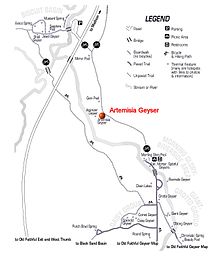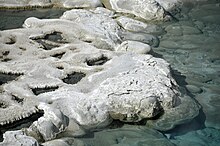
The geothermal areas of Yellowstone include several geyser basins in Yellowstone National Park as well as other geothermal features such as hot springs, mud pots, and fumaroles. The number of thermal features in Yellowstone is estimated at 10,000. A study that was completed in 2011 found that a total of 1,283 geysers have erupted in Yellowstone, 465 of which are active during an average year. These are distributed among nine geyser basins, with a few geysers found in smaller thermal areas throughout the Park. The number of geysers in each geyser basin are as follows: Upper Geyser Basin (410), Midway Geyser Basin (59), Lower Geyser Basin (283), Norris Geyser Basin (193), West Thumb Geyser Basin (84), Gibbon Geyser Basin (24), Lone Star Geyser Basin (21), Shoshone Geyser Basin (107), Heart Lake Geyser Basin (69), other areas (33). Although famous large geysers like Old Faithful are part of the total, most of Yellowstone's geysers are small, erupting to only a foot or two. The hydrothermal system that supplies the geysers with hot water sits within an ancient active caldera. Many of the thermal features in Yellowstone build up sinter, geyserite, or travertine deposits around and within them.
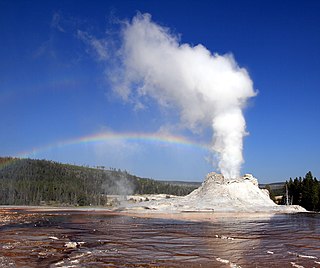
Castle Geyser is a cone geyser in the Upper Geyser Basin of Yellowstone National Park. It is noted for the particularly large geyserite sinter deposits, which form its cone. These deposits have been likened in appearance to a castle.

Turban Geyser is a geyser in the Upper Geyser Basin of Yellowstone National Park in the United States.

Comet Geyser is a geyser in the Upper Geyser Basin of Yellowstone National Park in the United States.

Anemone Geyser is a geyser in the Upper Geyser Basin of Yellowstone National Park in the United States. Anemone is actually two closely related geysers. The larger of the two is known as Big or North Anemone while the smaller is known as Little or South Anemone. The two geysers were named after the anemone flower by the Hague Party in 1904. Both vents have a pale yellow color and shape similar to the flower.

A-0 Geyser is a geyser in the Lower Geyser Basin of Yellowstone National Park in the United States.
Spindle Geyser is a geyser in the Lower Geyser Basin of Yellowstone National Park in the U.S. state of Wyoming.

Botryoidal Spring is a fountain-type geyser in the Lower Geyser Basin of Yellowstone National Park in the United States.
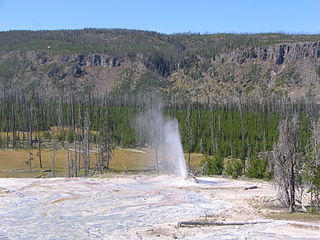
Atomizer Geyser is a cone geyser in the Upper Geyser Basin of Yellowstone National Park in the United States. Atomizer Geyser is part of the Cascade Group which also includes Artemisia Geyser. The geyser is named for a fine mist resembling the spray from an atomizer that is ejected during major eruptions.

Artesia Geyser is a geyser in the Lower Geyser Basin of Yellowstone National Park in the United States. Artesia Geyser is located on the edge of Firehole Lake and is part of the Black Warrior Group which includes Young Hopeful Geyser, Grey Bulger Geyser, and Steady Geyser.

Aurum Geyser is a geyser in the Upper Geyser Basin of Yellowstone National Park in the United States, on Geyser Hill.
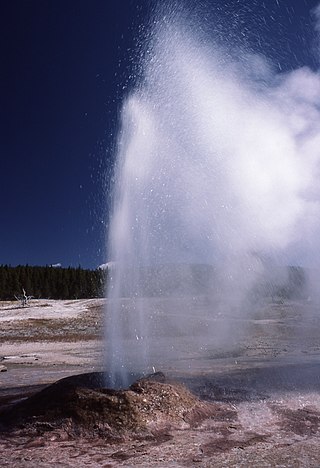
Pink Cone Geyser is a cone-type geyser in the Lower Geyser Basin of Yellowstone National Park in the United States. It is part of the Pink Cone Group. Other geysers in this groups include Bead Geyser, Box Spring, Dilemma Geyser, Labial Geyser, Labial's Satellite Geyser, Narcissus Geyser, and Pink Geyser.

Excelsior Geyser Crater, formerly known as Excelsior Geyser, is a dormant fountain-type geyser in the Midway Geyser Basin of Yellowstone National Park in the United States. Excelsior was named by the Hayden Geological Survey of 1871.

Beehive Geyser is a geyser in the Upper Geyser Basin of Yellowstone National Park in the United States. The 4-foot (1.2 m) tall cone resembles a straw beehive. Beehive's Indicator is a small, jagged cone-type geyser located about 10 feet (3.0 m) from Beehive.

Emerald Spring is a hot spring located in Norris Geyser Basin of Yellowstone National Park.
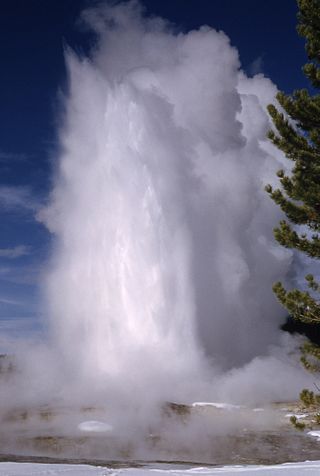
Giant Geyser is a cone-type geyser in the Upper Geyser Basin of Yellowstone National Park in the United States. Giant Geyser is the namesake for the Giant Group of geysers, which, on its platform, includes Bijou Geyser, Catfish Geyser, Mastiff Geyser, the "Platform Vents," and Turtle Geyser. Giant Geyser's Platform, a raised stone structure incorporating all these geysers. Giant is notable for its spectacular, but sporadic eruptions, as well as for its very large cone of geyserite, which stands about 12 feet tall.

Doublet Pool is a hot spring in the Upper Geyser Basin of Yellowstone National Park, Wyoming.

White Dome Geyser is a geyser located in the Lower Geyser Basin in Yellowstone National Park in the United States.

Sawmill Geyser, named for the whirring sound it makes during its eruption, is a geyser in Yellowstone National Park, Wyoming, United States. The geyser was named by Antoine Schoenborn of the Hayden Geological Survey of 1871.

Opal Pool is a hot spring in the Midway Geyser Basin of Yellowstone National Park, Wyoming. Opal Pool usually has a temperature of approximately 132 °F (56 °C). Though usually active as a hot spring, Opal Pool is considered a fountain-type geyser.


